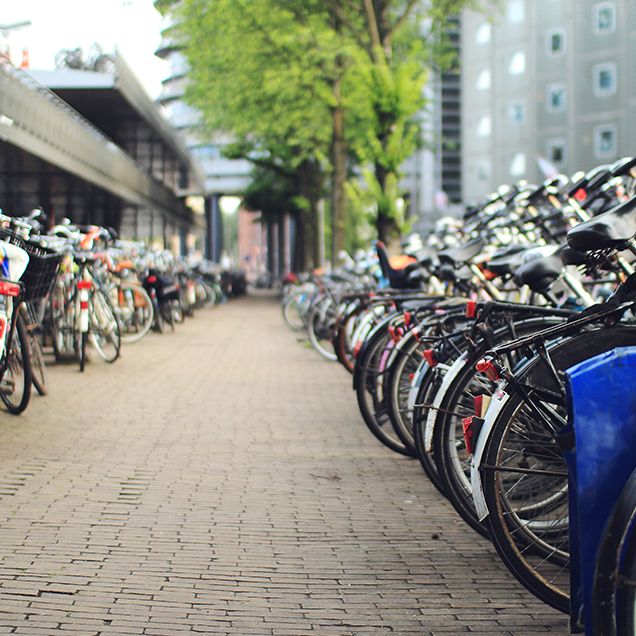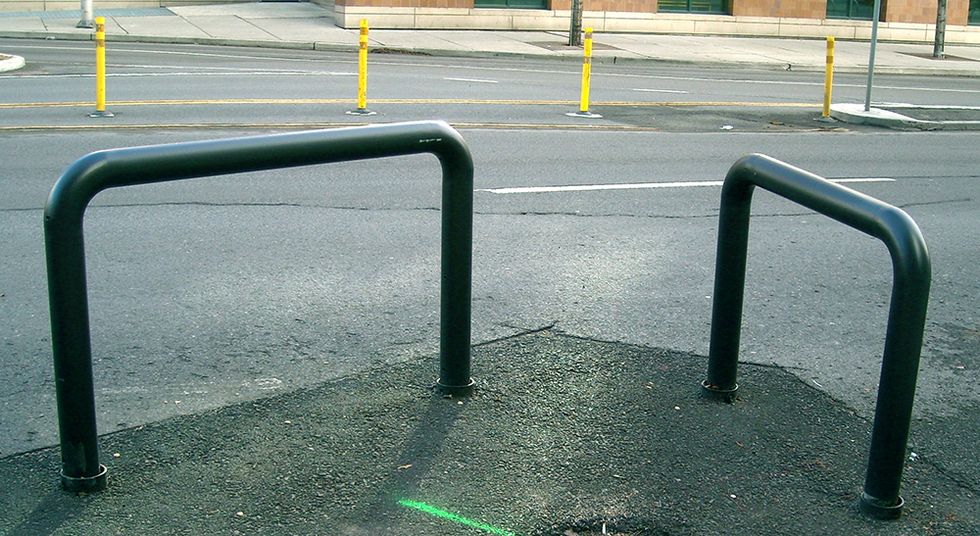Sure, there are a lot of ways to help grow the bicycle movement and make life on two wheels even better. But few have a greater, more immediate impact than…wait for it… Parking.
Providing bicycle parking is one of those magically simple actions that have a disproportionately huge impact. On a micro scale, any small business owner can, for a couple hundred bucks or less, provide a reasonably secure, dry spot for people to park their bikes. For cities and developers looking to accommodate the largest number of personal vehicles for the lowest price, bike parking is a godsend with a massive return on investment.
RELATED: How to Check Whether a Bike Rack is Safe to Use
There are many types of bicycle-parking structures out there, but the most basic, classic, secure, and affordable is called the bike staple. Shaped like its namesake, this $200, U-shaped piece of steel tubing is screwed securely into concrete and can hold two or more bicycles. At the very least, installing just one bike staple is an easy way to help employees prevent their reliable mode of transportation from walking away during the day. At best, it represents two more prime parking spots by the door for customers looking to make a quick purchase. And it serves as a billboard proclaiming to passersby that your business values sustainability and welcomes customers who arrive on two wheels.
RELATED: Underground Bike Parking in Japan
Bicycle parking provides more revenue than an equivalent area of car parking and no wonder. You can fit 10 or more bicycles into a single on-street car parking space. This design is usually called a bike corral. A survey in Portland, Oregon, found that, despite initial skepticism, customer-oriented businesses absolutely adore bike corrals: They increase parking capacity by 400 to 800 percent, calm traffic, and draw eyes toward them and the businesses near them. Potential revenue goes up as well. The science of bicycle economics is still in its infancy, but studies around the world are starting to show that cycling customers tend to spend more money at local businesses than their counterparts who arrive by car. The cyclists buy less on each trip, but make more trips.
Anecdotal evidence for the economic prowess of the bike corral continues to build, from the popular one in front of the Standing Stone Brewery in tiny Ashland, Oregon, to the DIY efforts of businesses like Avoca Coffee in Fort Worth, Texas. Here's how to make bike parking work for you:
Ask For It Where You Shop
If you shop at a place that doesn’t offer bike parking, ask for it. Business owners often don’t know that they have customers who arrive by bike. When they do realize it, they are among the most motivated to add parking spots and enjoy the massive return on investment they bring.
Ask For It Where You Work
Ditto with your workplace. Employers are growing more and more cognizant of the benefits of encouraging employees to bike commute: Studies have shown that bike commuters take fewer sick days, are on time more often, and are more productive at work than people who drive. A secure room for employees to lock their bikes isn’t always feasible, but many workplaces allow staffers to bring their bikes inside regardless.
Install Staples Right
Bike staples are among the best types of bike parking, but be smart about installing them—make sure they are placed so that a bike can easily be parked at each long side (not too close to a building or to each other). Make sure they’re in a visible and convenient location. And drill them into concrete with screws that can’t be removed by thieves with simple tools.
RELATED: The World’s Coolest Bike Infrastructure
Convert Car Spots
Bike corrals—which replace one or two on-street car parking spots with 10 to 20 bicycle parking spots—are an extremely popular and cost-effective way for cyclists, cities, and businesses to work together to create a win-win-win situation. If your city isn’t excited about these yet, it’s time to get them on board!
This article was originally published on the "Everyday Rider" blog on Bicycling.com.














